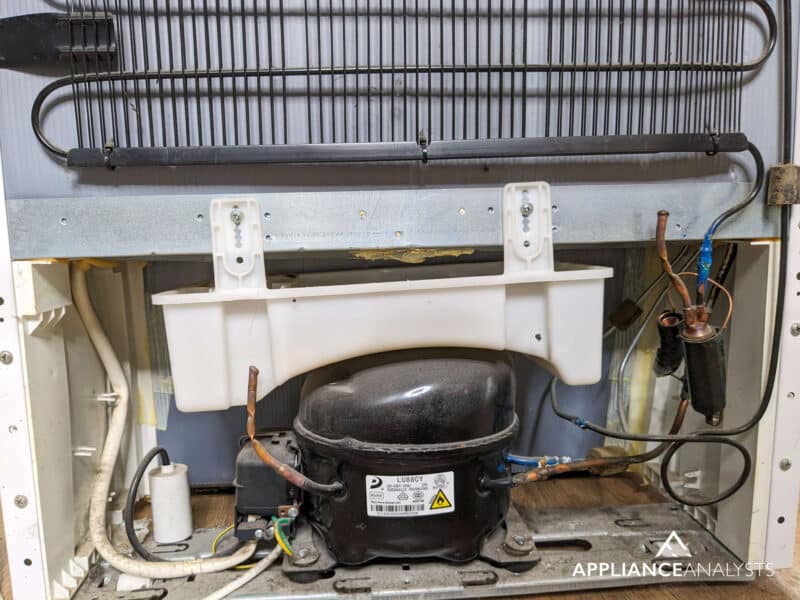Are your fridge and circuit breaker not on good terms?
A refrigerator is a major appliance, and can draw quite a lot of electricity. This can sometimes cause a surge – tripping the circuit breaker – but this shouldn’t be a regular occurrence.
If your fridge regularly trips the circuit breaker, your circuit may be overloaded. Try unplugging other appliances to solve the issue. If the refrigerator keeps tripping the breaker – then there may be an electrical fault in the compressor.
The long story short is that the compressor, when turning on to cool the fridge, is what’s causing the malfunction.
The good news is that you can follow the simple steps below to do a bit of troubleshooting yourself. The bad news is that you may still need to call out a pro if these steps don’t work. Please bear in mind these are provided as advice only – don’t do anything you’re not confident or qualified to do, call an expert instead if needed.
With that said, let’s dive in to the details.
What You’ll Need
You actually don’t need that many tools to prevent your fridge from tripping your circuit breaker. This is because the basic repairs involve unscrewing a few things and replacing a defective piece of electronics. The more intensive repairs should be done by electricians only because they are more demanding. They can even involve replacing your entire circuit breaker box.
Here’s a few of the supplies you’ll need depending on what the cause of the problem is:
- Screwdrivers
- Nut driver
- New GFCI outlet
- Voltage detector (or a working lamp)
- Wire cutters
- Your smartphone (for taking pictures of wiring)
How to Fix a Fridge That Keeps Tripping Your Circuit Breaker
A fridge that keeps tripping your circuit breaker is a real nuisance. This can disrupt the day-to-day lives of everyone in your house. Let’s get this fixed before it becomes a more serious issue.
#1 Tripping Your GFCI
Did you know that there’s more than one type of electrical outlet in your home?
There’s a special type of outlet known as a GFCI. These are also called ground fault circuit interrupters. These special outlets are typically put in locations that can become wet. They are more sensitive to electrical currents. A GFCI is designed to be a first line of defense against electric shock and fire in more hazardous situations.
You can spot a GFCI because it will have two buttons in between the plugs. One button will be labeled test and the other will be called a reset. Before we check any of the other fixes on this list, we’re going to make sure that the GFCI your fridge is plugged into is working.
Here’s a few steps you can take to make sure that the GFCI isn’t actually the source of your problem:
- Unplug your fridge
- Press the “test” button on your GFCI
- You should hear a clicking noise when the button is fully depressed
- Press the “reset” button on your GFCI
- You should hear a softer clicking noise and the outlet should be reset
- Plug your fridge back in
#2 Overloading Your Circuit Breaker
We’ve all had to go down into the basement and flip a switch in the breaker box, but what’s actually going on behind the scenes?
Your circuit breaker prevents electricity from overloading in your home. Consider it one big safety device that’s preventing accidental shocks and fires. Your circuit breaker is where all of the circuits in your home meet.
Most of the large appliances in your home will have their own circuits. You’ll see labels for individual appliances on your breaker box. These let you know which switches control which appliances.

Your fridge may or may not have its own circuit. The best practices dictate that a fridge should have its own dedicated circuit, but it’s not technically required. Sometimes your fridge will share a circuit with the rest of your kitchen.
If your fridge does share a circuit with the rest of your kitchen, they can trip your circuit breaker more frequently. One way to test this is to plug your fridge in a different room. If the circuit for that room trips, then you know your fridge is causing the problem.
The best fix for this is to have an electrician run a dedicated circuit just for your refrigerator. This will also help make things easier down the road when trying to fix other circuit breaker problems.
#3 Inspect the Power Cord
The power cord that connects your refrigerator to the outlet could be the source of your problems.
You want to inspect the cord for a few things. Take a look at the outside of the cord to make sure that there’s no holes or cuts in the protective outer coating. These are often caused by rodents chewing on the cord or they can also be caused by accident. Never run your refrigerator’s power cord underneath anything heavy like a shelf or another appliance. This can damage the cord.

You also want to inspect the prongs on the cord. The prongs should be free of discoloration and be straight. If your prongs look burnt out or they are crooked, it’s time to replace your fridge’s power cord.
Here’s how you can replace your fridge’s power cord:
- Unplug your fridge
- Turn off the water supply to the fridge
- Remove the rear access panel. You may need to detach the water supply line in order to do this
- Unscrew the power cord retaining bracket from the base of the fridge
- Unscrew the grounding wire from the fridge
- Unplug the power cable from the cable harness
- Transfer the retaining bracket to the new power cable
- Screw the retaining bracket back into the fridge
- Attach the grounding wire of the new power cord to the fridge
- Plug the new power cord into the cable hardness
- Reattach the rear access panel
- Reattach the water line if necessary
- Plug your fridge back in
#4 Check for a Damaged Outlet
We’ve been talking a lot about the outlet that your fridge plugs into, but what happens when the problem is with the outlet itself?
Outlets can burn out and become damaged just like any other electronic connection. If your outlet is worn out or it’s causing a short, it could be the source of your tripping circuit breaker. Here’s what you should look for.
Your outlet should sit firmly in the wall and not jiggle or come out when you unplug your fridge. The outlet should also be free of any obvious signs of a short such as scorch marks. Replacing your outlet can be done DIY, but it’s a good idea to call an electrician if you’re unsure of the process.
Here’s how you can switch out your damaged outlet:
- Shut off the power to that outlet. This is done by either flipping the breaker box’s switch for that outlet or by removing the fuse from the fuse box
- Check that the power is out at that outlet with a voltage detector or by plugging in a lamp that you know is in working condition
- Unscrew the outlet faceplate
- Unscrew the outlet from the wall
- Take a picture of the wiring with your smartphone so you know how things are wired later on
- Take the broken outlet to your hardware store and get an exact replacement
- Reattach the wires exactly as they were
- Start with the green or bare copper wire. This is the ground and should always been connected first
- Next connect the white wires
- Finally connect the rest of the wires to your new outlet
- Make sure none of the wires are touching each other—especially the ground wire
- You’ll need about ½ inch of exposed wire to connect to the new outlet. You can use your wire cutters to strip away insulation to expose the needed amount of wire
- Screw your outlet back into the wall
- Screw the faceplate back onto the outlet
- Turn on the outlet by flipping the switch at the breaker box or by putting the fuse back into the fuse box
- Test the outlet with a voltage detector or a working lamp
#5 Look for Damaged in Your Breaker Box
Breaker boxes have largely replaced fuse boxes throughout North America. In a fuse box, you have to replace a fuse every time a circuit trips. However, all you need to do is flip the switch in the breaker box to reset it.
If your fridge keeps tripping your breaker box, the problem could be with the box itself. Here’s what you should look for when inspecting your breaker box.
Look for any obvious signs of electrical damage. This often appears as black scorch marks on or around your breaker box. Other signs of an electrical problem could be melting on any of the plastic components or burning smell. Cracks, signs of pests, and signs of water damage are all also potential problems with your breaker box.
If you notice any of these common signs of a failing breaker box, call your electrician right away. Your breaker box is a key part of your home’s safety and should be repaired immediately if damaged.
#6 It Could be Your Compressor
Your compressor uses a lot of electricity and when it cools down your fridge. This can trip your circuit breaker. This is especially the case if the compressor relay has become faulty. Luckily, it’s very easy to change out your air compressor relay.

Here’s how it’s done:
- Unplug your fridge
- Unscrew the rear access panel
- Remove the wire retainer that holds down the compressor relay
- Detach the compressor relay from the cable harness
- Remove the run capacitor from the old start relay
- Connect the new start relay to the run capacitor
- Plug the compressor relay back into the write harness
- Secure the compressor relay with the wire retainer
- Reconnect the rear access panel
- Plug your fridge back in
If you want to get any replacement part – or see how much one would cost – click to enter your model number in the search bar below. Our partners at AppliancePartsPros stock almost every part with free guides on how to install them.

Fridge Still Tripping The Breaker?
If these tips haven’t helped – don’t worry. There may be other quick fixes you can try.
We’re fortunate enough to have a lot of readers on our website, but unfortunately, I can’t answer everyone’s questions personally. To help, we’ve teamed up with JustAnswer to connect you to a qualified Appliance expert.
You can connect with an appliance expert below, who will help you solve your specific issue. They do charge a small trial fee, so just remember to cancel the trial once you get your refrigerator working again.







